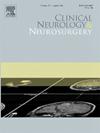显微外科切除与立体定向放射手术治疗Spetzler-Martin III级动静脉畸形的比较分析:一项多中心倾向评分匹配研究。
IF 1.8
4区 医学
Q3 CLINICAL NEUROLOGY
引用次数: 0
摘要
背景:Spetzler-Martin (SM) III级脑动静脉畸形(BAVMs)是介于低级别和高级别之间的过渡性危险区域,其特征是血管结构多样。主要的治疗选择是血管内栓塞、显微外科切除(MS)和立体定向放射外科(SRS)。本研究比较了MS和SRS的疗效和结果。方法:我们进行了一项多中心回顾性研究,纳入了MISTA数据库中2010年至2023年间接受MS或SRS治疗的SM III级BAVMs患者。倾向匹配基于年龄、表现时良好的修正Rankin评分(mRS)、病灶大小、破裂状态、定位深度和口才。结果:经配对后,60例患者平均分为MS组和SRS组。中位年龄(MS: 45.0 vs. SRS: 42.5岁,p = 0.3)和AVM大小(MS: 3.2 vs. SRS: 2.9 cm3, p = 0.6)相似。最后一次随访时,MS组的闭塞率(93.3 %)高于SRS组(46.7 %)(p 0.9)。MS组出血1次,SRS组无出血(p > 0.9)。SRS组的有利结果(mRS 0-2)高于MS组(93.3 % vs 80.0 %,p = 0.3),MS组有1例avm相关死亡率。结论:MS和SRS治疗SM III级BAVMs是可行的治疗方法。治疗选择应由多学科团队根据患者的目标进行个体化。本文章由计算机程序翻译,如有差异,请以英文原文为准。
A comparative analysis of microsurgical resection versus stereotactic radiosurgery for Spetzler-Martin grade III arteriovenous malformations: A multicenter propensity score matched study
Background
Spetzler-Martin (SM) Grade III brain arteriovenous malformations (BAVMs) represent a transitional risk zone between low- and high-grade BAVMs, characterized by diverse angioarchitecture. The primary treatment options are endovascular embolization, microsurgical resection (MS), and stereotactic radiosurgery (SRS). This study compares the efficacy and outcomes of MS and SRS.
Methods
We conducted a multicenter, retrospective study involving patients from the MISTA database with SM Grade III BAVMs treated with MS or SRS between 2010 and 2023. Propensity matching was based on age, favorable modified Rankin Score (mRS) at presentation, nidus size, rupture status, location depth, and eloquence.
Results
After matching, 60 patients were equally divided between MS and SRS groups. Median age (MS: 45.0 vs. SRS: 42.5 years, p = 0.3) and AVM size (MS: 3.2 vs. SRS: 2.9 cm3, p = 0.6) were similar. MS showed higher obliteration rates (93.3 %) compared to SRS (46.7 %) at the last follow-up (p < 0.001). The median time to obliteration post-SRS was 31.5 months (IQR: 15.3–60.0). SRS obliteration rates were 19 %, 29 %, and 59 % at 24, 36, and 60 months, respectively. Overall complication rates (MS: 30 % vs. SRS: 20 %, p = 0.4) and permanent complications (MS: 10 % vs. SRS: 13.3 %, p > 0.9) were similar. Hemorrhage occurred once in the MS group and none in the SRS (p > 0.9). Favorable outcomes (mRS 0–2) were higher with SRS than MS (93.3 % vs 80.0 %, p = 0.3), with one AVM-related mortality in the MS group.
Conclusion
MS and SRS are viable treatments for SM Grade III BAVMs. Treatment choice should be individualized by a multidisciplinary team, considering patient goals.
求助全文
通过发布文献求助,成功后即可免费获取论文全文。
去求助
来源期刊

Clinical Neurology and Neurosurgery
医学-临床神经学
CiteScore
3.70
自引率
5.30%
发文量
358
审稿时长
46 days
期刊介绍:
Clinical Neurology and Neurosurgery is devoted to publishing papers and reports on the clinical aspects of neurology and neurosurgery. It is an international forum for papers of high scientific standard that are of interest to Neurologists and Neurosurgeons world-wide.
 求助内容:
求助内容: 应助结果提醒方式:
应助结果提醒方式:


